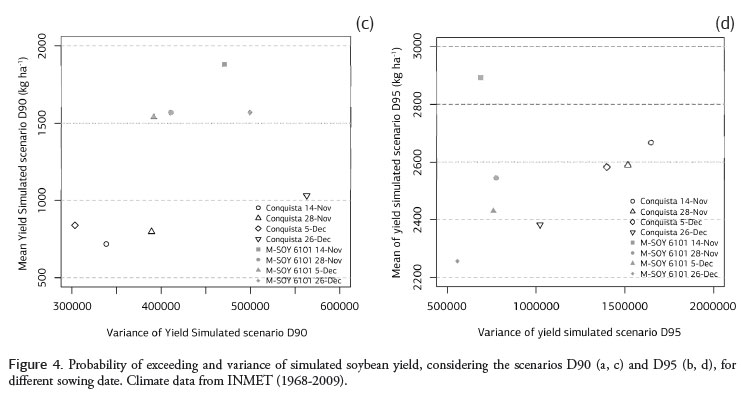In recent years, crop models have increasingly been used to simulate agricultural features. The DSSAT (Decision Support System for Agrotechnology Transfer) is an important tool in modeling growth; however, one of its limitations is related to the unaccounted-for effect of diseases. Therefore, the goals of this study were to calibrate and validate the CSM CROPGRO-Soybean for the soybean cultivars M-SOY 6101 and MG/BR 46 (Conquista), analyze the performance and the effect of Asian soybean rust on these cultivars under the environmental conditions of Viçosa, Minas Gerais, Brazil. The experimental data for the evaluation, testing, and adjustment of the genetic coefficients for the cultivars, M-SOY 6101 and MG/BR 46 (Conquista), were obtained during the 2006/2007, 2007/2008 and 2009/2010 growing seasons. GLUE (Generalized Likelihood Uncertainty Estimation) was used for the estimation of the genetic coefficients, and pedotransfer functions have been utilized to estimate the physical characteristics of the soil. For all of the sowing dates, the early season cultivar, M-SOY 6101, exhibited a lower variance in yield, which represents more stability with regard to the interannual climate variability, i.e., the farmers who use this cultivar will have in 50% of the crop years analyzed, a higher yield than a late-season cultivar. The MG/BR 46 (Conquista) cultivar demonstrated a greater probability of obtaining higher yield in years with favorable weather conditions. However, in the presence of the Asian soybean rust, yield is heavily affected. The early cultivar, M-SOY 6101, showed a lower risk of being affected by the rust and consequently exhibited less yield loss considering the scenario D90 (condensation on the leaf surface occurs when the relative humidity is greater than or equal to 90%), for a sowing date of November 14.
DSSAT; calibration; validation; modeling; rust epidemics











